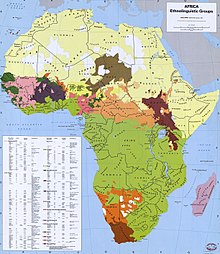This article should specify the language of its non-English content, using {{lang}}, {{transliteration}} for transliterated languages, and {{IPA}} for phonetic transcriptions, with an appropriate ISO 639 code. Wikipedia's multilingual support templates may also be used. (June 2020) |

In many parts of sub-Saharan Africa, the use of music is not limited to entertainment: it serves a purpose to the local community and helps in the conduct of daily routines. Traditional African music supplies appropriate music and dance for work and for religious ceremonies of birth, naming, rites of passage, marriage and funerals.[1] The beats and sounds of the drum are used in communication as well as in cultural expression.[2]
African dances are largely participatory: there are traditionally no barriers between dancers and onlookers except with regard to spiritual, religious and initiation dances. Even ritual dances often have a time when spectators participate.[3] Dances help people work, mature, praise or criticize members of the community, celebrate festivals and funerals, compete, recite history, proverbs and poetry and encounter gods.[4] They inculcate social patterns and values. Many dances are performed by only males or females.[5] Dances are often segregated by gender, reinforcing gender roles in children. Community structures such as kinship, age, and status are also often reinforced.[6] To share rhythm is to form a group consciousness, to entrain with one another,[7] to be part of the collective rhythm of life to which all are invited to contribute.[8]

Yoruba dancers and drummers, for instance, express communal desires, values, and collective creativity. The drumming represents an underlying linguistic text that guides the dancing performance, allowing linguistic meaning to be expressed non-verbally. The spontaneity of these performances should not be confused with an improvisation that emphasizes the individual ego. The drummer's primary duty is to preserve the community.[9] Master dancers and drummers are particular about the learning of the dance exactly as taught. Children must learn the dance exactly as taught without variation. Improvisation or a new variation comes only after mastering the dance, performing, and receiving the appreciation of spectators and the sanction of village elders.[10]
The music of the Luo, for another example, is functional, used for ceremonial, religious, political or incidental purposes, during funerals (Tero buru) to praise the departed, to console the bereaved, to keep people awake at night, to express pain and agony and during cleansing and chasing away of spirits, during beer parties (Dudu, ohangla dance), welcoming back the warriors from a war, during a wrestling match (Ramogi), during courtship, in rain making and during divination and healing. Work songs are performed both during communal work like building, weeding, etc. and individual work like pounding of cereals, winnowing.
- ^ C. Stapleton and C. May, African All-stars, Paladin 1989, page 5.
- ^ " African music." Encyclopædia Britannica. 2009. Encyclopædia Britannica Online[permanent dead link]
- ^ African Dance. Kariamu Welsh, 2004, Chelsea House Publishers, page 35. ISBN 0791076415
- ^ Steppin' on the Blues by Jacqui Malone. University of Illinois Press. 1996. page 9. ISBN 0-252-02211-4
- ^ African Dance. Kariamu Welsh, 2004, Chelsea House Publishers, pages 19,21. ISBN 0791076415
- ^ Africana: The Encyclopedia of the African and African American Experience by Henry Louis Gates, Anthony Appiah 1999 Basic Civics Books page 556 ISBN 0-465-00071-1
- ^ Rhythm As A Tool For Healing and Health in The Aging process Archived July 23, 2011, at the Wayback Machine
- ^ Sebastian Bakare, The Drumbeat of Life, WCC Publications, Geneva, Switzerland. 1997.
- ^ "Topic Three". Department of Communication Studies, University of North Texas. Archived from the original on August 3, 2010.
- ^ Zimbabwe Dance. Kariamu Welsh Asante. Africa World Press, Inc. 2000, p. 60 ISBN 0-86543-492-1
© MMXXIII Rich X Search. We shall prevail. All rights reserved. Rich X Search
